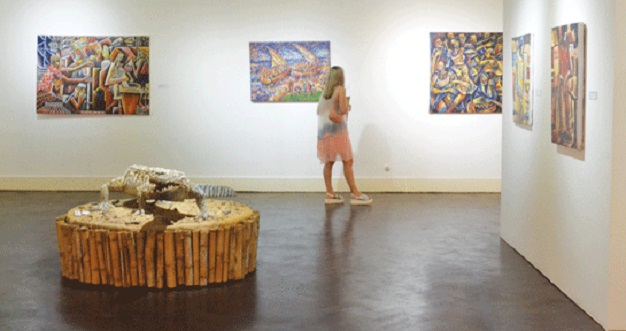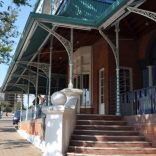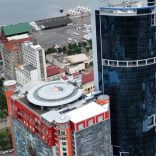Mozambique: Léo Cote and Mélio Tinga win the Mia Couto Prize
Inside the National Museum of Art

Domingo
Among the places one may usually find works of art like paintings, sculpture, woodcuts, photographs, and suchlike are galleries, workshops and living rooms. But where are the works of national artists put to serve the national history? That would be the National Museum of Art in Maputo, also known as MUSART.
The museum is located on Ho Chi Minh Avenue, two commercial establishments after its intersection with Karl Max Ave. As the cars rattle past outside, we serenely introduce ourselves to the man at the front desk, who, contrary to our expectations, replies: “Closed to the public. No visitors – we have no electricity”.
Plans notwithstanding, we return the following day. Friday, the day of chance. We are lucky – the gallery is open. From a distance, the white-painted building looks like a normal house but those who enter inevitably notice that it stands directly opposite the Maputo municipal police station.
The steel and glass door of the museum receives the visitor, who enters to be welcomed by a sandalwood Samussone Macamo sculpture.
The 1990s work recalls the peaceful Rome Agreement times and is entitled “A United People”. In the same room, the same sculptor’s “Union of Forces” represents national unity and the recognition of all art as proclaiming the Mozambican identity, beyond which is a screen on which one sees anything that “Has Nothing to Do with Us”.
We had forgotten. On arrival we were greeted by Cândido Foliche, from the Museum’s Department of Educational Services, who is our guide
Museum for national works
The project of creating a National Museum of Art emerged after independence as providing an environment for Mozambican artists to present their works. Our guide, calm and quiet, told us that the goal was also to bring together works by national and other artists who could tell the history of the country.
Foliche told us there were no purpose-built premises available, so the solution was to use the former headquarters of the Indo-Portuguese Goa Institute.
At the same time, Mozambique began to generate policies relating to art. Lacking space, the house was adapted mainly for preservation, education and cultural appreciation.
In terms of content, the criteria was that artists had to present something to do with beauty and aesthetics. This “norm”, Foliche continues, created difficulties for national artists, who saw their works placed aside, neither exhibited nor conserved. It was necessary to restructure precepts to gain access to the museum.
“It ended up being decided that they must be works of national artists and that at that time they would have to be living here in Mozambique because it was a country that had just reached its independence and needed to quickly establish its national identity.”
This process took several years, but the Museum was opened on May 18, 1989, and has never closed since.
Small rooms
The museum has three exhibition halls, one temporary and the other two permanent. Though, “sometimes we dismantle a permanent exhibition to make room for a temporary one,” our guide explains.
The temporary gallery is on the ground floor. The atmosphere is tranquil. Works in various media, from painting to sculpture, acrylic, mixed media and cement among others line the walls. At the moment, it houses an exhibition of national artists, highlighting Vasco Manhiça’s “Country of Pandza” a work with which Manhiça won the gallery’s first prize in 2016, in addition to other works given Honourable awards.
Two other rooms are located on the first floor. There being no elevator, we climb the stairs to find works by Makukule, Ndlozi, Samate, Shikani, Malangatana, Chissano, Bertina Lopes among others.
The works in the three rooms are very close to each other. Our guide offers a commentary.
“Our hope is to have a slightly larger museum in terms of infrastructure. This is not exactly what a national museum should be. It has limitations in terms of dimensions, so we cannot show just any kind of work. You can see that our height limit is four metres. A seven-metre sculpture would not fit in here.”
In terms of accessibility, Cândido continues, one of the museum’s current challenges is facilities for disabled access.
But it is by no means simple for an artist to exhibit artwork. Cândido tells us that the museum holds contests for artists who want to exhibit, which a jury evaluates, eventually approving some works for display.
Generally speaking, MUSART prefers collective exhibitions over individual, but there are exceptions. “There are artists who have a trajectory worthy of being presented here. Usually we invite the person after an evaluation and recognition of their work.”
There is also a room that contains the Museum’s reserve collection, items of which are sometimes exhibited too. The museum currently has just over 2,000 works in total.
It is necessary to charge
After enjoying the masterpieces shown in the three rooms, we sit down to catch our breath and talk about the challenges of appreciating the artists’ works. Our interviewee said that the museum is mostly visited by students during the school year, but that, at the end of the year, it also has tourists.
The museum charges a fee to all visitors except students. “We have to charge. There are maintenance costs. At the national level, there is a certain standardization in terms of fees for visitors. The charge is within norms,” Cândido reveals, adding that the National Museum adheres also to international standards that govern the operation of similar institutions.
At the end of our visit, we leave the building behind us, but can still feel it there, static, waiting for more people to go and enjoy its works of art as we did.













Leave a Reply
Be the First to Comment!
You must be logged in to post a comment.
You must be logged in to post a comment.